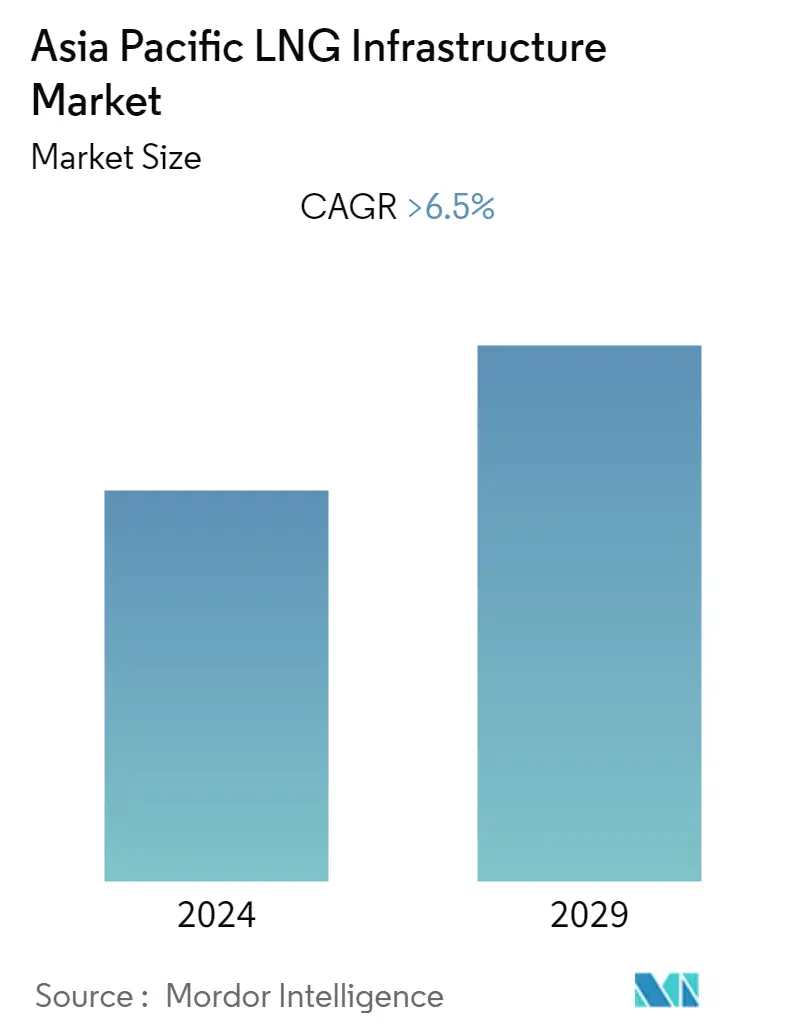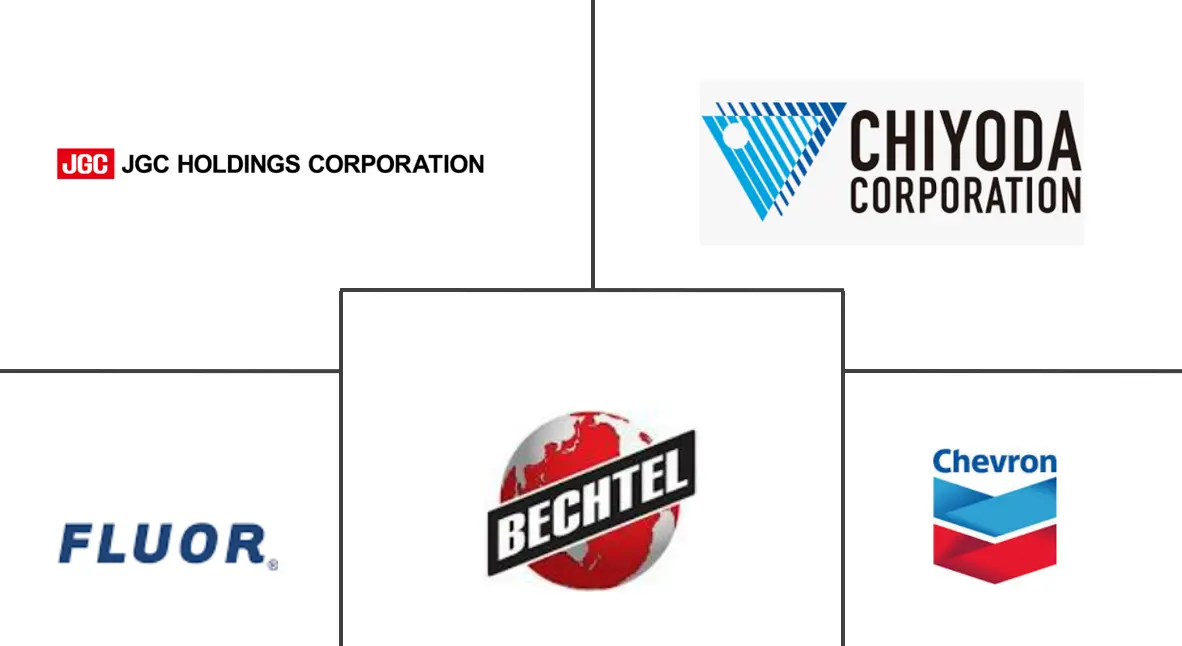Market Size of Asia Pacific LNG Infrastructure Industry

| Study Period | 2020 - 2029 |
| Base Year For Estimation | 2023 |
| Forecast Data Period | 2024 - 2029 |
| Historical Data Period | 2020 - 2022 |
| CAGR | > 6.50 % |
| Market Concentration | Low |
Major Players
*Disclaimer: Major Players sorted in no particular order |
APAC LNG infrastructure Market Analysis
The Asia Pacific LNG infrastructure market is projected to register a CAGR of over 6.5% during the forecast period (2022-2027).
The market was negatively impacted by COVID-19 in 2020. Presently the market has now reached pre-pandemic levels.
- Increasing demand for LNG in bunkering, road transportation, and off-grid power sectors, along with lower CAPEX requirements for LNG, is expected to drive the growth of the market studied.
- On the other hand, nuclear energy production and renewable technology developments in various regions are major restraints for the market.
- Nevertheless, as per the Energy Information Administration (EIA), non-OECD Asian countries like China, India, Bangladesh, Thailand, and Vietnam are expected to consume 120 billion cubic feet per day (bcf/d) of natural gas by 2050, outpacing regional natural gas production by 50 bcf/d. The supply imbalance in the region is likely to result in increasing dependency on the other regard ions, which is expected to create an excellent opportunity for the market players in the forecast period, as these projects are paving the way for the line pipe industry to grow more.
- China region dominates the market and is also likely to witness the highest CAGR during the forecast period. The LNG import was around 12 million tons in 2020, which increased to 79 million tons in 2021. Due to this surge in demand, China became the world's largest LNG importer, surpassing Japan. The increased demand is due to Chinese LNG buyers signing long-term contracts for more than 20 million tons a year.
APAC LNG infrastructure Industry Segmentation
LNG is natural gas that has been cooled to a liquid state, at about -260° Fahrenheit, for shipping and storage. The volume of natural gas in its liquid state is about 600 times smaller than its volume in its gaseous state. This process makes it possible to transport natural gas to places pipelines do not reach. The LNG infrastructure market is segmented by type and region. By type, the market is segmented into regasification terminals and liquefication terminals. The report also covers the market size and forecasts for the LNG infrastructure market across major countries. for each segment, the market sizing and forecasts have been done based on revenue (USD billion).
| Type | |
| Regasification Terminal | |
| Liquefication Terminal |
| Geography | |
| India | |
| China | |
| Japan | |
| Australia | |
| South Korea | |
| Rest of Asia Pacific |
Asia Pacific LNG Infrastructure Market Size Summary
The Asia Pacific LNG infrastructure market is experiencing a robust growth trajectory, driven by increasing demand for liquefied natural gas across various sectors such as bunkering, road transportation, and off-grid power. The market has rebounded to pre-pandemic levels after the setbacks caused by COVID-19. The region's growing energy needs, particularly in non-OECD countries like China, India, and Vietnam, are expected to outpace local natural gas production, creating a significant opportunity for LNG infrastructure development. However, the market faces challenges from the advancements in nuclear energy and renewable technologies, which could potentially restrain its growth. Despite these challenges, the demand for LNG is bolstered by its lower capital expenditure requirements compared to other energy sources, making it an attractive option for energy security and diversification.
China stands out as a dominant player in the Asia Pacific LNG infrastructure market, with its rapid increase in LNG imports positioning it as the world's largest importer. The country's strategic investments in LNG infrastructure, including regasification terminals, are expected to support its growing energy demands, particularly in the transportation and power generation sectors. The development of LNG fueling stations and the adoption of LNG as a low-carbon alternative to diesel fuel for heavy trucks are key drivers of market expansion. The fragmented market landscape includes major players such as JGC Holdings Corporation, Chiyoda Corporation, and Bechtel Corporation, who are actively involved in expanding LNG infrastructure. Collaborative efforts, such as those between Pavilion Energy and Zhejiang Hangjiaxin Clean Energy, highlight the ongoing initiatives to enhance LNG supply and infrastructure in the region.
Asia Pacific LNG Infrastructure Market Size - Table of Contents
-
1. MARKET OVERVIEW
-
1.1 Introduction
-
1.2 Market Size and Demand Forecast in USD billion, till 2027
-
1.3 Recent Trends and Developments
-
1.4 Government Policies and Regulations
-
1.5 Market Dynamics
-
1.5.1 Drivers
-
1.5.2 Restraints
-
-
1.6 Supply Chain Analysis
-
1.7 Porter's Five Force Analysis
-
1.7.1 Bargaining Power of Suppliers
-
1.7.2 Bargaining Power of Consumers
-
1.7.3 Threat of New Entrants
-
1.7.4 Threat of Substitutes Products and Services
-
1.7.5 Intensity of Competitive Rivalry
-
-
-
2. MARKET SEGMENTATION
-
2.1 Type
-
2.1.1 Regasification Terminal
-
2.1.2 Liquefication Terminal
-
-
2.2 Geography
-
2.2.1 India
-
2.2.2 China
-
2.2.3 Japan
-
2.2.4 Australia
-
2.2.5 South Korea
-
2.2.6 Rest of Asia Pacific
-
-
Asia Pacific LNG Infrastructure Market Size FAQs
What is the current Asia Pacific LNG Infrastructure Market size?
The Asia Pacific LNG Infrastructure Market is projected to register a CAGR of greater than 6.5% during the forecast period (2024-2029)
Who are the key players in Asia Pacific LNG Infrastructure Market?
JGC Holdings Corporation, Chiyoda Corporation, Bechtel Corporation, Fluor Corporation and Chevron corporation are the major companies operating in the Asia Pacific LNG Infrastructure Market.

